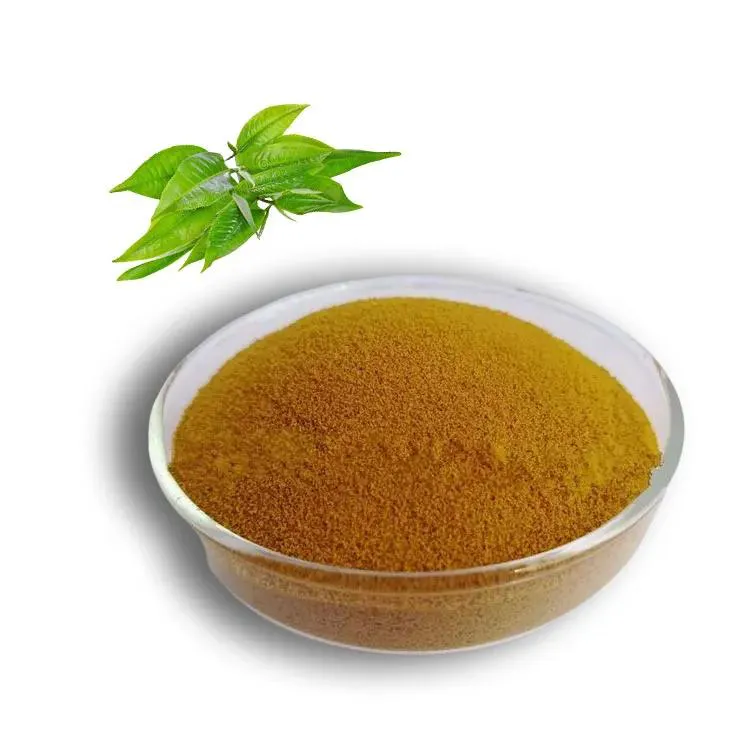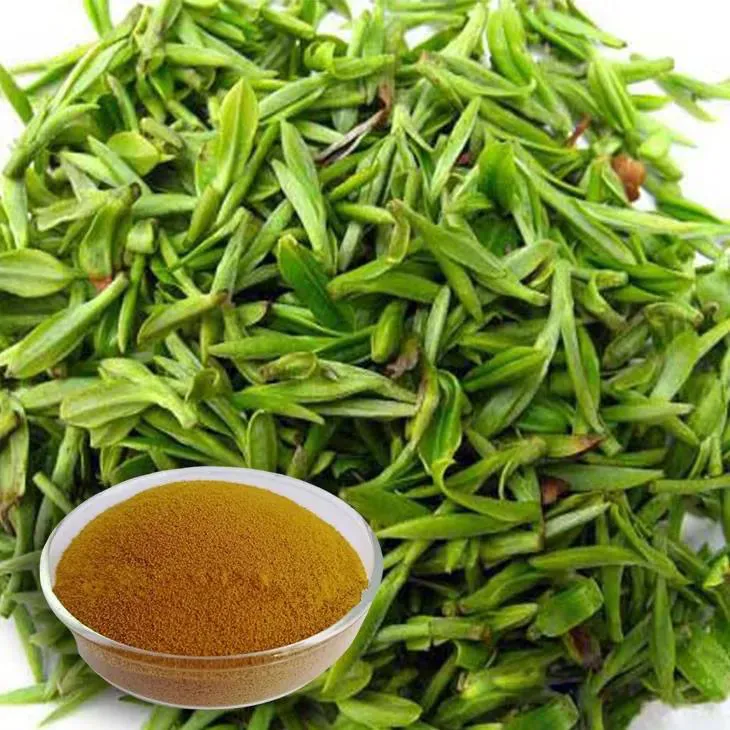- 0086-571-85302990
- sales@greenskybio.com
Green tea extract manufacturer.
2024-11-29

1. Introduction
Green Tea Extract manufacturers play a crucial role in the booming green tea - derived product industry. They are the key players responsible for transforming raw green tea into a wide range of valuable products. Green tea has been known for its numerous health benefits for centuries, and modern science has further validated its potential in areas such as antioxidant activity, weight management, and promoting heart health. As a result, the demand for high - quality Green Tea Extract has been on the rise globally.

2. Raw Material Procurement
The first step for Green Tea Extract manufacturers is the procurement of raw green tea materials. This is not a simple task as it demands in - depth knowledge of tea varieties and their quality characteristics.
2.1 Tea Varieties
There are numerous tea varieties available, and different types of green tea can have distinct flavors and nutrient profiles. For example, matcha - type green tea might be chosen for its unique flavor and high nutrient content in some high - end extract production. Matcha is a powdered form of green tea that is made from shade - grown tea leaves. It has a rich, vibrant green color and a unique umami flavor. Another popular variety is Sencha, which is a more common type of Japanese green tea with a fresh, grassy taste.
2.2 Quality Considerations
When procuring raw green tea, manufacturers need to consider several quality factors. These include the origin of the tea, as tea grown in certain regions may be of higher quality due to favorable soil and climate conditions. For instance, green tea from regions like Japan and China are often highly regarded in the market. The freshness of the tea leaves is also crucial. Fresher leaves tend to have higher levels of beneficial compounds such as catechins, which are the main active ingredients in green tea extract. Additionally, factors like the presence of pesticides or other contaminants need to be carefully monitored to ensure the safety and quality of the final extract.

3. The Manufacturing Process
The manufacturing process of green tea extract involves multiple steps to extract the beneficial components from the tea leaves. Each step is carefully designed and controlled to ensure the production of high - quality extract.
3.1 Drying
The first step in the manufacturing process is often drying. Drying helps to reduce the moisture content of the tea leaves, which is important for their preservation and subsequent processing. There are different drying methods available, such as air - drying, sun - drying, and machine - drying. Air - drying and sun - drying are more traditional methods that can help retain some of the natural flavors of the tea. However, machine - drying offers more control over the drying process and can be more efficient in large - scale production. During drying, the tea leaves are carefully monitored to ensure that they are dried evenly without over - drying, which could lead to a loss of beneficial compounds.
3.2 Grinding
After drying, the tea leaves are ground into a fine powder. Grinding is necessary to increase the surface area of the tea leaves, which facilitates the extraction process. The fineness of the powder can vary depending on the extraction method and the desired end - product. A finer powder generally allows for more efficient extraction as it exposes more of the internal components of the tea leaves to the extraction solvent.
3.3 Extraction
The extraction step is the core of the manufacturing process. It typically involves using either water or organic solvents depending on the end - use of the extract. Water extraction is a more natural and environmentally friendly method. It can extract a wide range of water - soluble compounds from the tea leaves, including catechins, flavonoids, and amino acids. However, organic solvents such as ethanol or ethyl acetate may be used in some cases, especially when targeting specific lipophilic compounds or for certain industrial applications. The extraction process is carefully controlled in terms of temperature, time, and solvent - to - tea ratio to optimize the yield and quality of the extract. After extraction, the resulting liquid is then processed further to remove any remaining solids or impurities.

4. Research and Development
Green tea extract manufacturers also engage in research and development (R & D) activities. These activities are essential for their long - term competitiveness in the market.
4.1 Improving Extraction Methods
Manufacturers strive to find new and improved extraction methods to enhance the yield and quality of the extract. For example, they may explore novel extraction technologies such as supercritical fluid extraction. Supercritical carbon dioxide can be used as an extraction solvent under specific pressure and temperature conditions. This method has several advantages, including being non - toxic, non - flammable, and leaving no solvent residues in the final product. By investing in R & D for extraction methods, manufacturers can not only increase the efficiency of their production processes but also produce extracts with higher levels of active ingredients.
4.2 Product Formulation
Another important aspect of R & D is formulating new products based on green tea extract. Manufacturers are constantly looking for ways to develop dietary supplements that target specific health benefits. For instance, they may develop products focused on weight loss. Green tea extract has been shown to have potential in increasing metabolism and fat oxidation, so manufacturers may combine it with other ingredients such as caffeine or fiber to create more effective weight - loss supplements. Similarly, for promoting cardiovascular health, they may formulate products that contain green tea extract along with other heart - healthy ingredients like omega - 3 fatty acids or CoQ10.
5. Marketing and Brand Building
Marketing and brand building are also important aspects for these manufacturers as they compete in a global market filled with both established and emerging players.
5.1 Target Market Identification
The first step in marketing is to identify the target market. Green tea extract products can target a wide range of consumers, from health - conscious individuals looking for natural dietary supplements to the food and beverage industry for use in functional foods and drinks. Manufacturers need to understand the needs and preferences of their target markets. For example, if targeting the health - conscious consumer, they may focus on highlighting the natural and health - promoting properties of green tea extract, such as its antioxidant and anti - inflammatory effects.
5.2 Brand Differentiation
With the increasing number of competitors in the market, brand differentiation is crucial. Manufacturers need to find ways to set their products apart from others. This can be achieved through product quality, unique formulations, or sustainable sourcing practices. For example, a manufacturer may promote its use of organic green tea sources or its strict quality control measures during the manufacturing process. Another way to differentiate is through packaging. Eye - catching and informative packaging can attract consumers and communicate the product's key features and benefits.
5.3 Global Market Expansion
The global market for green tea extract products offers significant opportunities for growth. Manufacturers need to develop strategies for global market expansion. This may involve establishing distribution channels in different countries, complying with international regulatory requirements, and adapting to local market cultures. For example, in some Asian markets, green tea is a traditional beverage, and manufacturers may focus on promoting green tea extract as a premium and concentrated form of green tea. In Western markets, they may need to educate consumers about the health benefits of green tea extract and position it as a modern and innovative dietary supplement.
6. Quality Control and Regulatory Compliance
Quality control and regulatory compliance are essential for green tea extract manufacturers to ensure the safety and effectiveness of their products.
6.1 Quality Control Measures
Manufacturers implement a series of quality control measures throughout the production process. This includes testing the raw materials for quality and purity, monitoring the manufacturing process parameters such as temperature and time, and conducting final product testing. Final product testing may involve analyzing the content of active ingredients, checking for contaminants, and ensuring the stability of the product. For example, the content of catechins in the green tea extract should be within a certain range to ensure its effectiveness, and there should be no detectable levels of harmful substances such as heavy metals or pesticides.
6.2 Regulatory Requirements
Green tea extract products are subject to various regulatory requirements in different countries. In the United States, for example, dietary supplements are regulated by the Food and Drug Administration (FDA). Manufacturers need to ensure that their products are labeled correctly, with accurate information about the ingredients, dosage, and potential health benefits. In the European Union, there are strict regulations regarding the safety and quality of food supplements, including those containing green tea extract. Manufacturers need to comply with these regulations to be able to sell their products in the EU market. Additionally, in some countries, there may be specific requirements for claims made about the health benefits of green tea extract, and manufacturers need to have scientific evidence to support such claims.
7. Conclusion
Green tea extract manufacturers are involved in a complex and multi - faceted business. From procuring the right raw materials to conducting research and development, manufacturing high - quality products, and building strong brands in the global market, they face numerous challenges and opportunities. By continuously focusing on quality control, regulatory compliance, and innovation, these manufacturers can contribute to the growth of the green tea - derived product industry and meet the increasing demand for healthy and natural products.
FAQ:
What are the key factors in procuring raw green tea materials for manufacturers?
For manufacturers, in - depth knowledge of tea varieties and their quality characteristics is crucial when procuring raw green tea materials. Different tea varieties have different flavors and nutrient contents. For example, matcha - type green tea may be selected for high - end extract production due to its unique flavor and high nutrient content.
What are the main steps in the manufacturing process of green tea extract?
The manufacturing process of green tea extract involves multiple steps. Firstly, the tea leaves are dried, then ground. After that, extraction is carried out using either water or organic solvents, which depends on the end - use of the extract.
Why do green tea extract manufacturers engage in research and development?
Green tea extract manufacturers engage in research and development to find new and improved extraction methods. This helps to enhance the yield and quality of the extract. They also work on formulating new products based on green tea extract, such as dietary supplements for specific health benefits like weight loss or improved cardiovascular health.
How important is marketing and brand building for green tea extract manufacturers?
Marketing and brand building are very important for green tea extract manufacturers. They are competing in a global market full of both established and emerging players. A strong brand and effective marketing can help them stand out and gain more market share.
What are some of the potential health benefits targeted by green tea extract - based products?
Some of the potential health benefits targeted by green tea extract - based products include weight loss and improved cardiovascular health. Manufacturers formulate dietary supplements with these benefits in mind.
Related literature
- Green Tea Extract: Properties, Preparation and Application"
- "The Role of Green Tea Extract in the Food and Nutraceutical Industries"
- "Green Tea Extract: A Review of Its Composition, Health Benefits and Manufacturing Processes"
- ▶ Hesperidin
- ▶ citrus bioflavonoids
- ▶ plant extract
- ▶ lycopene
- ▶ Diosmin
- ▶ Grape seed extract
- ▶ Sea buckthorn Juice Powder
- ▶ Beetroot powder
- ▶ Hops Extract
- ▶ Artichoke Extract
- ▶ Reishi mushroom extract
- ▶ Astaxanthin
- ▶ Green Tea Extract
- ▶ Curcumin Extract
- ▶ Horse Chestnut Extract
- ▶ Other Problems
- ▶ Boswellia Serrata Extract
- ▶ Resveratrol Extract
- ▶ Marigold Extract
- ▶ Grape Leaf Extract
- ▶ blog3
- ▶ Aminolevulinic acid
- ▶ Cranberry Extract
-
The best lemon juice powder in nature.
2024-11-29
-
Organic Vitamin K2 Powder Suppliers
2024-11-29
-
Bulk purchase of L - tyrosine.
2024-11-29
-
Vitamin K2 Manufacturers
2024-11-29
-
Alfalfa Meal
2024-11-29
-
Sophora Flavescens Root Extract
2024-11-29
-
Cranberry Extract
2024-11-29
-
Citrus Aurantii Extract
2024-11-29
-
Clove Powder
2024-11-29
-
Agaricus Blazei Extract
2024-11-29
-
Horse Chestnut Extract
2024-11-29
-
Fig Extract
2024-11-29
-
Cactus Extract
2024-11-29
-
Tinospora cordifolia extract
2024-11-29























